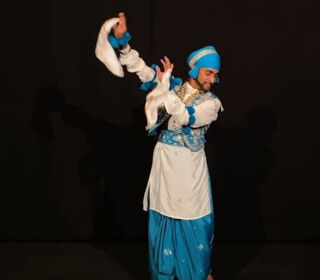
Blog Article

As a multidisciplinary artist, I have been exploring my identity and heritage with an array of projects over the last two decades. Much of this research has been undertaken in the field of Bhangra, and was also the focus of my Masters-by-Research degree. During this process, as with any body of research, I have been open to new lines of enquiries which I wanted to explore further.
The main one being the disparity and hierarchy of dance forms found within India and the diaspora. Although never overtly stated, the classical dances have a greater importance to the arts than traditional folk dances, and in my opinion this can be seen in the fact that there has been very little to no government funding given to art forms such as Bhangra. In fact, during my last visit to India I came to the stark realisation that there was not even a square-inch of the country where it originated from, dedicated purely to its practice in the form of a centre or institute.
My academic and creative outputs aim to re-address this unbalance and give weight to the artform of Bhangra. One of my most recent projects was The Bhangra Lexicon compiled in 2021, and is the world's first 'visual dictionary' of Bhangra movements. This Bhangra ‘repertoire’ has given me a deeper understanding of the movements within Bhangra and the confidence to employ these movements to new creative processes.
In February 2022, I was involved in a project with other South Asian dancers across the UK that used storytelling in their practice. Kathak and Bharatanatyam dancers employ dance as a mode of storytelling very naturally. On the other hand, Bhangra has almost exclusively been used as a form of expressing happiness and joy. For my contribution, I used pre-recorded videos of movements that expressed moments of happiness and love, from the Bhangra Lexicon. I then edited these into a video of me narrating the story of Sohni-Mahiwal.
The following month I was invited to take part in the ‘India-UK Creative Industries at 75: Challenges and Opportunities’ project. It gave me the unique opportunity to work with fellow artists in India from different creative genres. Whilst the introductions took place, I hoped that I would get the chance to work with Saurav Sharma, as he described his work and the relevance of Sufi music in his outputs. This turned out to be the case and when we had a chance to begin our collaborative process, I expressed an interest in exploring the story of Sohni-Mahiwal further. It was decided that this would be mixed with Saurav’s vocals along with his friend and colleague, Sarthak Pawar’s, love of progressive rock/metal creating a new piece of music for me to perform to.
When I heard the music that had been produced, I was both excited and nervous at the same time. To my knowledge, elements of rock and metal had been used in Bhangra recordings in the 80s from bands such as DCS; although, Bhangra dance had never been used to enact a dramatic scene of sorrow and loss as felt by Sohni or Mahiwal in the story. As a male dancer I had to embody the feelings of Sohni which were being felt by Mahiwal on the other side of the shore, two lovers, two people with one shared soul. I used elements of performing arts, choreography and freestyle dance to convey those emotions and dance to the ‘Panjabi-prog-rock’ track Kandey Uthey/Along the Shore.
I am also extremely excited to be able to continue these explorations with both Saurav and Sarthak with further research and in-turn push new creative boundaries with the use of music, story-telling and Bhangra!